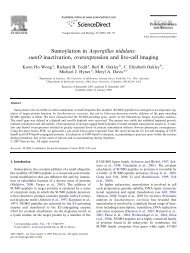Ice nucleation active bacteria and their potential role in precipitation
Ice nucleation active bacteria and their potential role in precipitation
Ice nucleation active bacteria and their potential role in precipitation
You also want an ePaper? Increase the reach of your titles
YUMPU automatically turns print PDFs into web optimized ePapers that Google loves.
ERCA 6 95<br />
The part of the gene responsible for the C-term<strong>in</strong>al of the prote<strong>in</strong> codes for hydrophilic doma<strong>in</strong>s that are<br />
highly variable among the different alleles. The largest portion of the gene codes for the central core of<br />
the prote<strong>in</strong>. In all alleles studied, this core has a common motif – a sequence that is repeated - of 24,<br />
48 <strong>and</strong> 144 nucleotides. This translates <strong>in</strong>to repeats of 8, 16 <strong>and</strong> 48 am<strong>in</strong>o acids. The details of these<br />
repeated sequences are highly similar ("conserved") among the predicted correspond<strong>in</strong>g INA prote<strong>in</strong>s,<br />
particularly with<strong>in</strong> the 48-am<strong>in</strong>o acid repeat. The shorter repeats are less similar, with stretches of higher<br />
<strong>and</strong> lower repetition. This periodicity is <strong>in</strong> accordance with ice <strong>nucleation</strong> activity <strong>in</strong> orient<strong>in</strong>g molecules<br />
of identical structure (water) <strong>and</strong> act<strong>in</strong>g as a template for ice formation. A model of the prote<strong>in</strong> encoded<br />
by the <strong>in</strong>aZ gene from the bacterium P. syr<strong>in</strong>gae (proposed by Kasava <strong>and</strong> L<strong>in</strong>dow [80, 81]) depicts the<br />
structure as a cha<strong>in</strong> of repeated octapeptides (segments of 8 am<strong>in</strong>o acids) form<strong>in</strong>g a series of loops, a<br />
secondary prote<strong>in</strong> structure called β-str<strong>and</strong>s. As part of the mechanism by which this prote<strong>in</strong> <strong>in</strong>itiates ice<br />
formation, it has been proposed that there is a conformational change on this prote<strong>in</strong> that is driven by<br />
<strong>bacteria</strong>l metabolism <strong>and</strong> that <strong>in</strong>volves redistribution of ionic charge lead<strong>in</strong>g to an exceptionally good<br />
ice nucleat<strong>in</strong>g site – especially at warm temperatures [82].<br />
6.2. Expression of the ice <strong>nucleation</strong> activity<br />
The physics underly<strong>in</strong>g the mechanisms by which INA prote<strong>in</strong>s catalyze ice formation require further<br />
exploration. But even if we understood the complexities of the physics, they would likely be outshone<br />
by the biological variability <strong>in</strong> the production of effective ice nuclei by <strong>bacteria</strong>. Firstly, <strong>bacteria</strong> produce<br />
<strong>and</strong> ma<strong>in</strong>ta<strong>in</strong> <strong>active</strong> INA prote<strong>in</strong>s <strong>in</strong> <strong>their</strong> cell membrane as a function of environmental conditions.<br />
Environment is the overrid<strong>in</strong>g cause of variability <strong>in</strong> <strong>bacteria</strong>l ice <strong>nucleation</strong> activity; differences <strong>in</strong> the<br />
structure of the gene among <strong>bacteria</strong> have not been shown to be related to expression of effective INA<br />
prote<strong>in</strong>s. The ma<strong>in</strong> triggers for expression of ice <strong>nucleation</strong> activity by <strong>bacteria</strong> are cool temperatures<br />
(









